Farming is by far the single most important activity that can boost the Nigerian economy going forward aside from education and technology.
In case you don’t know, continuous evangelism for carbon-neutral society, green energy, and conservation of the environment is gradually reducing the global demand for crude oil, and one day, the world will switch to alternative energy sources that are much more sustainable.
It’s also important I point out that a move to alternative energy sources that do not pollute the environment also means less income for countries like Nigeria whose economy is solely dependent on crude oil export.
So what is the Nigerian government doing?
Nothing per se that I can pinpoint is working as regards diversifying the economy. In fact, the only trending sector of the economy in Nigeria aside from petroleum/crude oil is politics. And any country where politics thrives more than its industry is really going nowhere.
In addition, most Nigerians are now very lazy and depend majorly on white-collar jobs, crude oil money, foreign investors’ cash, and money embezzled in political posts.
Anyways, agriculture is the way forward and that’s why I have decided to write this article. And this is not to say that agriculture does not have its own challenges. In fact, they are numerous and that’s why many youths are not involved in it.
For example, the land is a major constraint.
It is very rare to see farmland close to residential areas, and those that are quite far, lack enough security not to talk about being expensive to purchase and manage. Hence we can as well conclude that many youths don’t have access to accessible and well-secured farmland.
As matter of fact, I did go to the ministry of works in my state(Oyo) and made a request for hectares of farmland, but it surprises me that after paying and writing a letter to the necessary department, I did not get any response talkless of getting any land. So I’ve come to the conclusion that youth don’t have access to arable land that’s nearby, well-secured, cheap, and easy to manage.
So what type of agriculture can the youth start? LIVESTOCK FARMING I think.
And what type of livestock farming can be done in a house compound that requires less space and doesn’t pollute the environment, that’s fish farming.
Fish farming is very lucrative because out of all livestock being reared, only fishes can give you 1kg of meat/flesh from every 1.1 kg of feed I.e. it has the most efficient feed conversion ratio(FCR). As a matter of fact, cattle are the least efficient. They eat up to 10kg of feed to build up 1kg of meat/flesh.
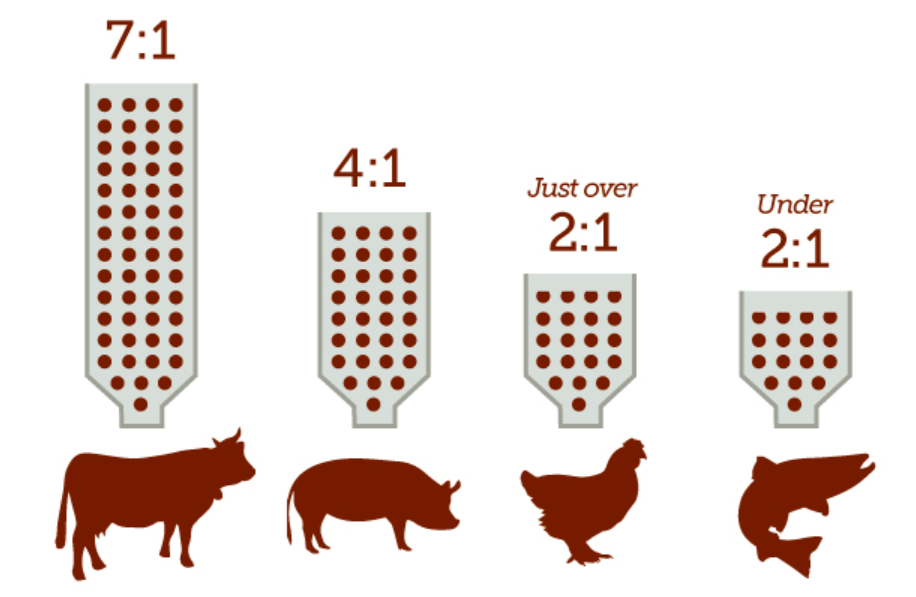
Anyways, before I digress totally, let’s move on to how you can start your own profitable catfish farming business.
Actually, a lot of considerations will need to be made before you decide to start a fish farm but here is a simple guide with probable cost estimates in case you have already made up your mind.
1. Water Source
The first step is to have a steady source of clean water. This is very cogent because water is the natural habitat of fishes and without it, most fishes cannot survive; just like it would be difficult for most humans to survive without houses.
So what are the available sources of water; the most common source of water is the stream(which you can channel into your fish ponds) or a Borehole which you can power with electricity and store the water into an overhead tank.
Another less common source of water is a river where people practice cage culture, that is they put those fishes in cages with tiny wire mesh holes and leave the cages hanging in the river. Using this method, you don’t need to change any water as the river flows automatically thus bringing in freshwater and taking out their waste.

2. Fish Pond
Once you have your water source, the next step is to decide on which type of fish habitat or pond to construct. I have listed below the 3 common types of ponds with their advantages and disadvantages below:
- Earthen pond: The advantage of using this type of pond is that it can contain a whole lot of fish, and there’s less mortality due to cannibalism because small fishes can hide in mud. Another benefit is that It grows a lot of green algae which fishes can feed on, so you may spend slightly lesser on fish feed. On the contrary, it’s prone to flooding in the rainy season. Also, it’s not mobile and it’s a bit difficult to secure if it’s far from your house.

Image credit: Erikohlsen - Concrete pond: This type of pond is very durable and can contain a whole lot of fish. Contrarily, it’s expensive to construct. It’s also not mobile and may leak often or sustain large cracks if not used.
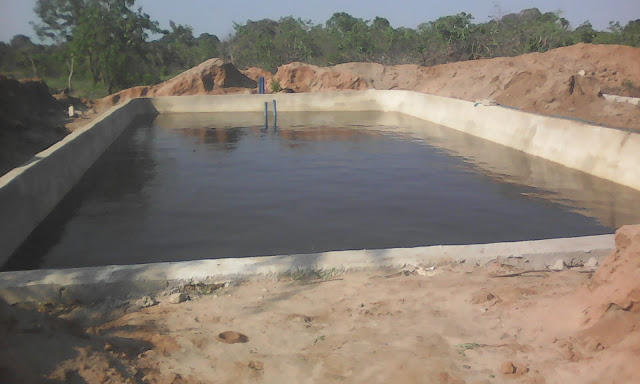
Image credit: AMISODAGO CONSULTANCY FIRM - Tarpaulin: This pond is mobile, easy to construct(in fact you can do it yourself), and has low maintenance. You can decide to use it in a rented or family apartment. The only disadvantage is that you will need to change the water often.

Image credit: Jiji Fish Ponds
The tarpaulin pond in particular is the best choice for newbie fish farmers. I strongly recommend it if the place you’re using is not your own house. This is simply because it’s mobile and easy to construct. And if your landlord decides to send you packing, you can easily dismantle it and set it up somewhere else unlike earthen or concrete ponds that are not mobile.
Also, the tarpaulin pond is easy to secure. You can decide to place it directly outside your windows so you can watch it regularly. The tarpaulin is also durable and can last for 3 to 5 years after which you can decide to repair or just buy a new one.
I always recommend the small size of 5ft by 5ft by 3ft depth or a big size of 5ft by 10ft by 3ft depth because they can fit into any area within your compound.
You will need to do little plumbing work to bring water into and out of your tarpaulin. This you can achieve by calling a plumber and buying the materials or doing it yourself through the use of a water hose to bring in water and a sieve to prevent small fishes from escaping when taking water out.
Also, you need to work out a drainage system to take water away from your fish farm. Your fellow residents won’t take it lightly with you if water from your pond doesn’t find a way out and as a result, fouls the air of the environs.
You can call me at +234 810 185 0909 to purchase your quality and durable tarpaulin pond or click here to place your order online.
Note: We deliver nationwide. You will get it delivered to the nearest interstate pack in your location.
3. Getting small fish to rear.
You can stock your new fish farm with any of the following small fish inputs.
- Fries
- Fingerlings
- Juveniles
- Jumbo

I will suggest you take Juveniles because at that stage they’re relatively cheap and can withstand harsh weather conditions(they don’t easily die). However, make sure you’re placing an order from the right source as you may end up buying rungs or fishes with low quality that will only consume feed and not grow big.
I made this mistake when I started; I bought some jumbo sizes not knowing that they were of less quality and the farmer already separated the shooters(fast-growing Juveniles) and decides to sell the rest to me as rungs(slow growers). So sad, but I fell victim due to ignorance.
Note that you will need to prepare your pond before introducing your fishes. If it’s a tarpaulin pond, you can erect and wash it with salt to ensure the chemicals on it doesn’t affect the fish. Also, you can put water in the tarpaulin and leave it for 3 days to be sure it isn’t leaking. This also reduces the smell and effect of the preservative chemicals on the tarpaulin itself.
For concrete or earthen pond, you can add lime or ashes to fertilize it. This will also allow green algae to grow on the earthen pond, thus providing more food for the fish.
After doing all these vital preparatory steps, you can introduce your fish.
You can contact me at +234 810 185 0909 in case you need Juveniles. I will sell to you if you’re close by or get someone near you. I’m also more focused on selling organic fish, which her the ones they hatch without the use of growth hormones like Ovulin and Ovaprime. This is another reason you should buy from me.
Sikemi Olabisis AKA The Farm Lady is also a good mentor of mine who can supply you with Juvenile catfish if you’re in Lagos. Here is her phone number: +234 810 676 9062.
4. Taking care of the fishes

Taking care of your young fish(juveniles) is a very interesting and cogent aspect of the catfish business. If you get this wrong, you would most likely get the business wrong or at least become unprofitable. It is divided into 4 parts namely; water management, feed management, sun and weather management, and diseases management.
- Water management: This has to do with how you change your water regularly and ensures the water is safe, clean, and suitable for the growth of the fishes. If you’re capable of changing your water daily, that would be fine but economically I will suggest every 3 days(2 or 3 times per week). If you have a very large number of tarpaulin ponds and you need a lot of water, you may consider digging 2 or more boreholes. Alternatively, you may not necessarily fill all the ponds to the brim at first. After the first 24 hours, you can add more water, the next 24 hours add more water, then change it completely after another 24 hours making it 3 days.
Some tools you would need here are; Generator set to pump water, an aerator to add more dissolved oxygen to your water, a hose to take water to the pond, and a submersible pump to take water out of the earthen pond. - Feed management: This is simply how you feed your fish for good health and profitability. Although fishes are very efficient at feed conversion, it’s advisable you know the right way to feed them so you can cut waste.
At the juvenile stage, I advise you to feed your fish with Ala Aqua fish feed 0.3 to 1.8mm feed. It has about 45% protein and would help boost the initial growth of your fish. Also, they are in 1kg size and cost about ₦2200 so you don’t need to buy a full bag. You just need two of the 1kg depending on the number of fish you’re raising.
When they exhaust the initial feed, you can switch to 2mm Ala Aqua fish feed which cost ₦14,700(for a bag of 15kg). This would be enough to feed 500 fish for a month.

Image credit: Olist Marketplace Next, you feed your fish with a 3mm skretting feed(₦14,000/bag of 15kg). After this, your fish should have a good Initial start and you can now switch to local feed which is a bit cheaper. I will suggest you buy local floating/extruded feed like Bluecrown or Ecofloat because they don’t pollute the water in the tarpaulin quickly. Also, buying fish feed from anyhow fish mill can reduce the growth of your fish because the ratio of protein and other ingredients in the feed might not be complete.
If it’s an earthen pond you can use the local floating feed suggested above or formulate your own sinking feed which is a lot cheaper. The sinking feed won’t pollute an earthen pond instead it would serve as manure which increases the growth of algae in the pond. Such algae serve as food for the fish.
You will need a scale to measure the feed you give your fish and the size of your fish regularly.
Ideally, you should feed the fish 5% of their body weight. You will need to find the average weight of your fish, next multiple by the total number of fish, then find 5% of it. That’s about the right amount to feed them daily. Divide that number by 2 if you’re feeding 2 times daily.
I will suggest you feed your fish twice daily(7 am and 5 pm) for the first 3 months after which you can switch to once-daily (5 pm).Also, you would need to do regular sorting in order to make sure you only have fish of the same size in the same pond. This will reduce cannibalism and aggression from bigger fishes.

Image credit: Sun News Online Also, make sure you feed your fish well.
-
You will need a minimum of 1kg feed to feed 1 catfish to 1kg. So 1000 catfish will need a minimum of 1000kg of feed to give you 1000kg of weight.
-
And if a bag of fish feed is about 15kg, you will need about 67 bags (1000/15) to feed 1000 catfish to table size(1kg each). Make sure you have enough money to feed your catfish.
-
67 bags * ₦8,000/bag = ₦536,000. That’s an estimate to feed 1000 fishes to table size of 1kg each(1000kg in total).
- If 1000kg costs ₦536,000, then 1kg is approximately ₦550(₦536,000/1000kg).
-
-
Sun and weather management: Small finishes don’t like too much sun so it’s advisable you get an asbestos or plastic roofing sheet to cover half of the tarpaulin. That way they have something like a shed to hide under and fresh air can still get to the surface of the pond.
Also, if your tarpaulin pond is placed very close to the house, you need to ensure that rainwater dropping from the pan doesn’t flow directly to them. This can cause roofing sheet iron or aluminum poisoning. -
Disease management: No farmer prays for its fish to have a disease outbreak but it’s somehow inevitable, and you must learn how to handle it.

Image credit: Research Gate -
It’s important you separate diseased or dead fish as soon as possible.
- The way to boost the fish’s immune system and cure minor illnesses is to pluck bitter leaves, blend them and add them to the pond water. You can also add some of the blended leaves to their feed. Almond leaves can also be used instead of bitter leaf.
- Antibiotics like Keprocyril can be used to boost their immune system and also cure some diseases.
- Some equipment you may need here is an aerator, water hose, a couple of buckets, and an extra pond.
-
5. Harvesting your fish.
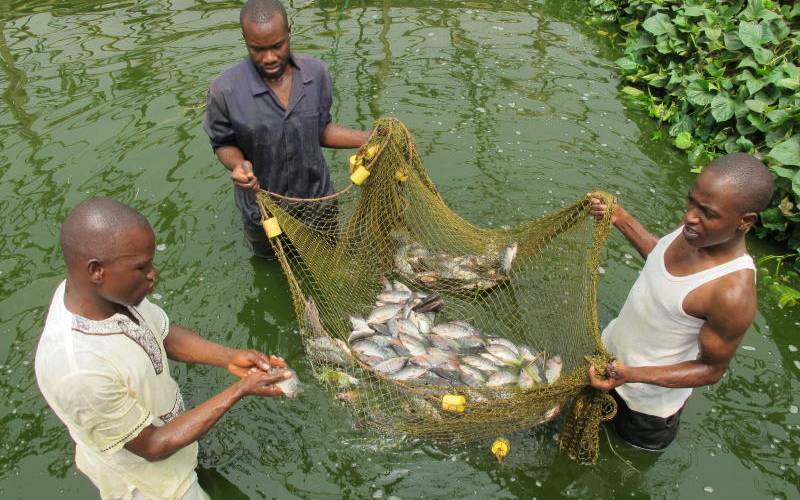
You can decide to harvest your fish after 2 months. At that size, they are good for smoking hence they call them a smokable size or millange.
If you don’t intend to smoke/oven-dry the fish and sell it, then you shouldn’t harvest your fish yet. I suggest you wait for 6 months when most of your fish would have reached table size(1kg) or 10 months when most of your fish would have reached an average weight of 2kg. That way, you would make enough profit because you would sell it per kg.
Another technique you can use is to harvest your fish at 4 months. Here you will sell half of them that have reached 1kg to off-takers(those that resell or go and process), while you smoke/oven-dry the remaining half that’s less than 1kg and also sell it yourself.
One thing you must note when harvesting is to have your own digital scale and harvest gradually so you won’t be at the mercy of bad off-takers that would price your fish badly.
Also, have a fish smoking kiln on your farm so that in case of unforeseen situations where you need to process all your fish or you might lose them. A good example was when petrol was scarce and there was no electricity. With such a predicament, you may not be able to manage a huge amount of fish in terms of changing their water regularly and ensuring diseases don’t occur.
6. Selling your catfish.

This greatly depends on the size of your farm and whether you’re selling the fresh fish or processing it further by oven drying it.
Generally, I will advise you to sell some of your fish fresh and oven-dry the rest. But there are some exceptions to that.
If you have a small farm and you intend to sell fresh fish, I will suggest you wait till your fishes get to 1kg and sell directly to those doing catfish barbecue or pepper soup. That way you make a good profit. Currently, the price of 1kg of catfish in Lagos and Ibadan is ₦1,200.
On the other hand, if you have a very large farm then you should wait for most of your fish to get to 1kg and then get off-takers in bulk so you can quickly recoup your money.
Note: Don’t sell your fish on credit to off-takers because most won’t payback. Also, they would tell you all sorts of stories and excuses that the fish died or they went at a loss when they sold. Always collect cash at sales so your business can continue to grow.
You may also smoke some of the fish and sell it in bulk to market women and supermarkets. You will need to package your oven-dried fish well enough with stickers and good-quality nylon.
Materials needed for harvesting and processing include:
- Harvesting net
- Smoking kiln
- Labels
- Packaging nylon
- Sealing machine
- Palm oil
- Knifes
- Buckets
- Salts etc.
7. Making a good profit from the catfish farming business
That you apply everything I share in this article is not a guarantee that you would make a lot of profit or be successful in the business. Here are some tips to help you become profitable
- Focus on reducing costs from the very beginning. Note that I didn’t say you should reduce quality, I only meant you should reduce the cost to the barest minimum. You can do this by only getting the most important equipment. Getting a lot of equipment will add to your cost, which in turn adds to the cost of your fish. And because many Nigerians have a low purchasing power of Nigerians, you will make less profit if you intend to sell in bulk or to resellers. So if you can do without an expensive machine or equipment, do without it.
- Hatch catfish yourself or find good farms where you can get good inputs(fingerlings or Juveniles). Hatching yourself will make you profitable but if you can’t, make sure you buy your inputs from the right source so you don’t just keep feeding fish that won’t really grow due to a disorder.
- Make sure you have the basic necessity on your farm to serve the amount of fish you’re stocking. Don’t stock 1000 catfish when the pond you have can only take 300 pieces, or when the money you have can only feed 300 to table size. Stocking too much will lead you to sell early which would not be profitable.
- Take the management and security of your farm seriously. Make sure you’re close to your farm and you’re the main manager of the farm. If you leave someone to handle it, you may not lose your fish but you may end up not profitable after 6 months of fish farming. Also, farms that are in an isolated places tend to attract thieves which makes your investment prone to losses.
- Selling directly to end-users. If you want to make more money in this business, sell directly to end-users like bars, supermarkets, restaurants, etc.
- Exporting your oven-dried catfish abroad is another way to really make good money from the catfish business. You will need to find customers in places like the United Kingdom(UK), US, Dubai, etc online and ship to them via platforms like Shiptonaija. If you get this right, you can make a lot of money. A Kg of dried catfish cost about ₦6,000 in Nigeria and about ₦14,000 in those countries.
8. Cost of raising 1000 catfish to table size
Below is a rough estimate of the cost of raising 1000 catfish
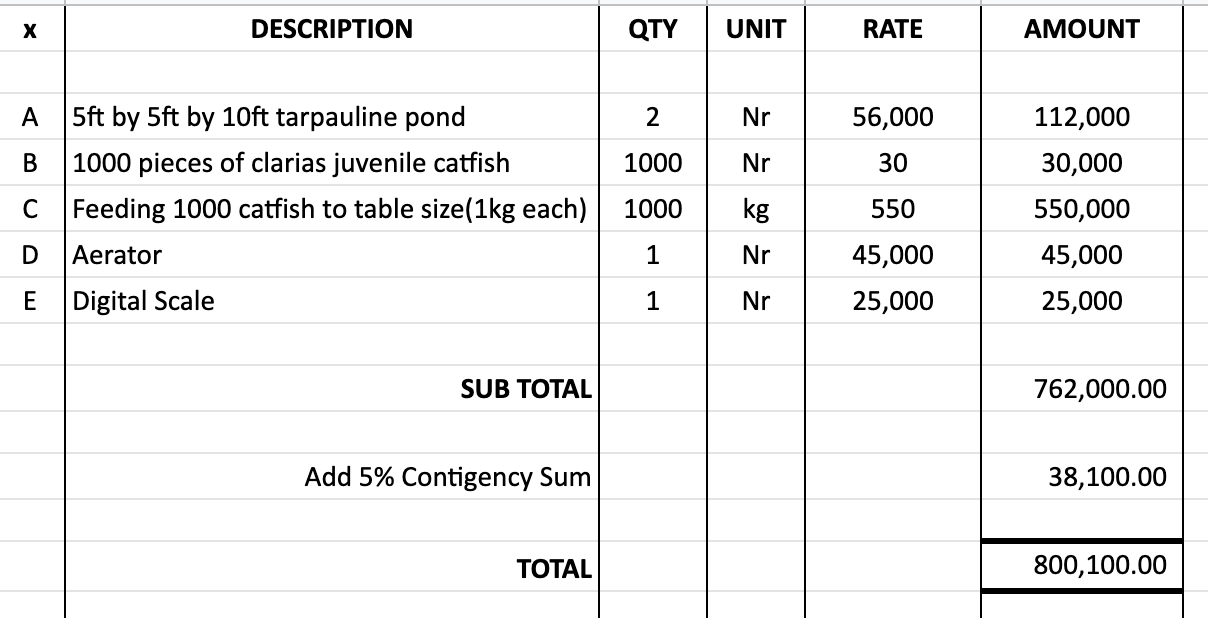
If you’re to sell the 1000 fish at ₦1200/kg, then you would make ₦1,200,000.
Your profit would be ₦1,200,000 – ₦800,100 = ₦399,900.
If you divide it by the 6 months of growing the fish, that’s ₦66,650 profit per months.
Do you think the monthly profit is worth it? Answer in the comments section 👇 .
9. Innovation in the catfish business
I’m currently doing some research on how we can improve catfish farming in Nigeria. My main area of focus is:
- Organic hatching: The non-use of growth hormones like ovuline and ovaprime in hatching
- Organi breeding: The non-use of antibiotics in the growing of fishes. Just organic feed and medicine.
- Vertical catfish farming: The growing of catfish in vertical ponds in areas with limited space.
What do you think? Feel free to reach out to me(+234 810 185 0909) if you find any of these interesting and you would like to support us.
10. Contacts of experts you can consult in the catfish business
If you want to get catfish fingerlings/juveniles or you need expert advice on how to start this business, feel free to call an of the experts below. Note: you may be charged a consultancy fee so don’t expect it to be free.
- Kehinde Lawal: +234 810 185 0909 – 9jacashflow.com – Nigeria
- Sikemi Olabisi: +234 810 676 9062 – The Farm Lady – Nigeria
- Afuome: +233 20 075 7738 – Afuom TV – Ghana
- Zactly: +234 810 291 9618 – Zactly Foods & Farms – Nigeria



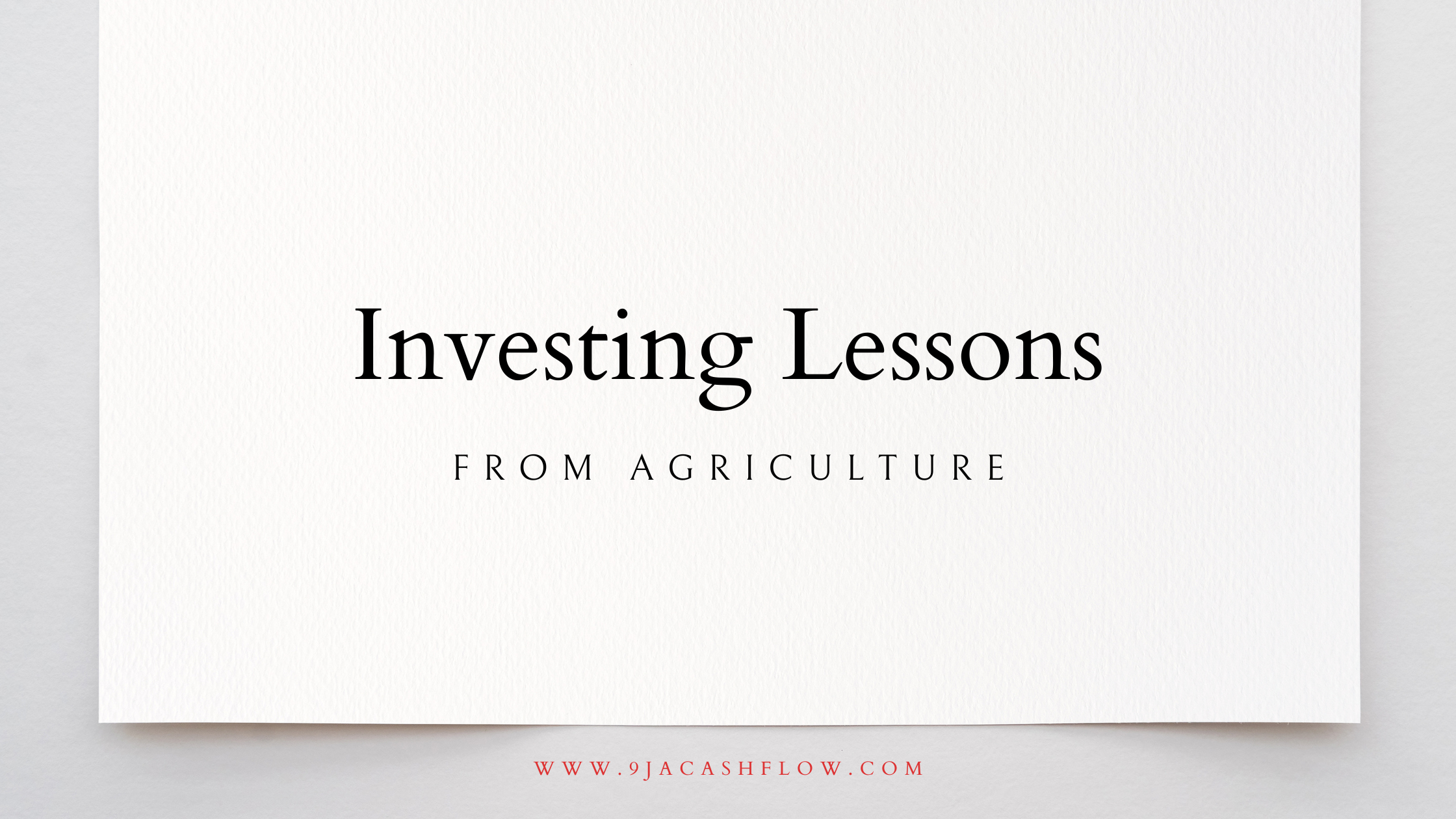
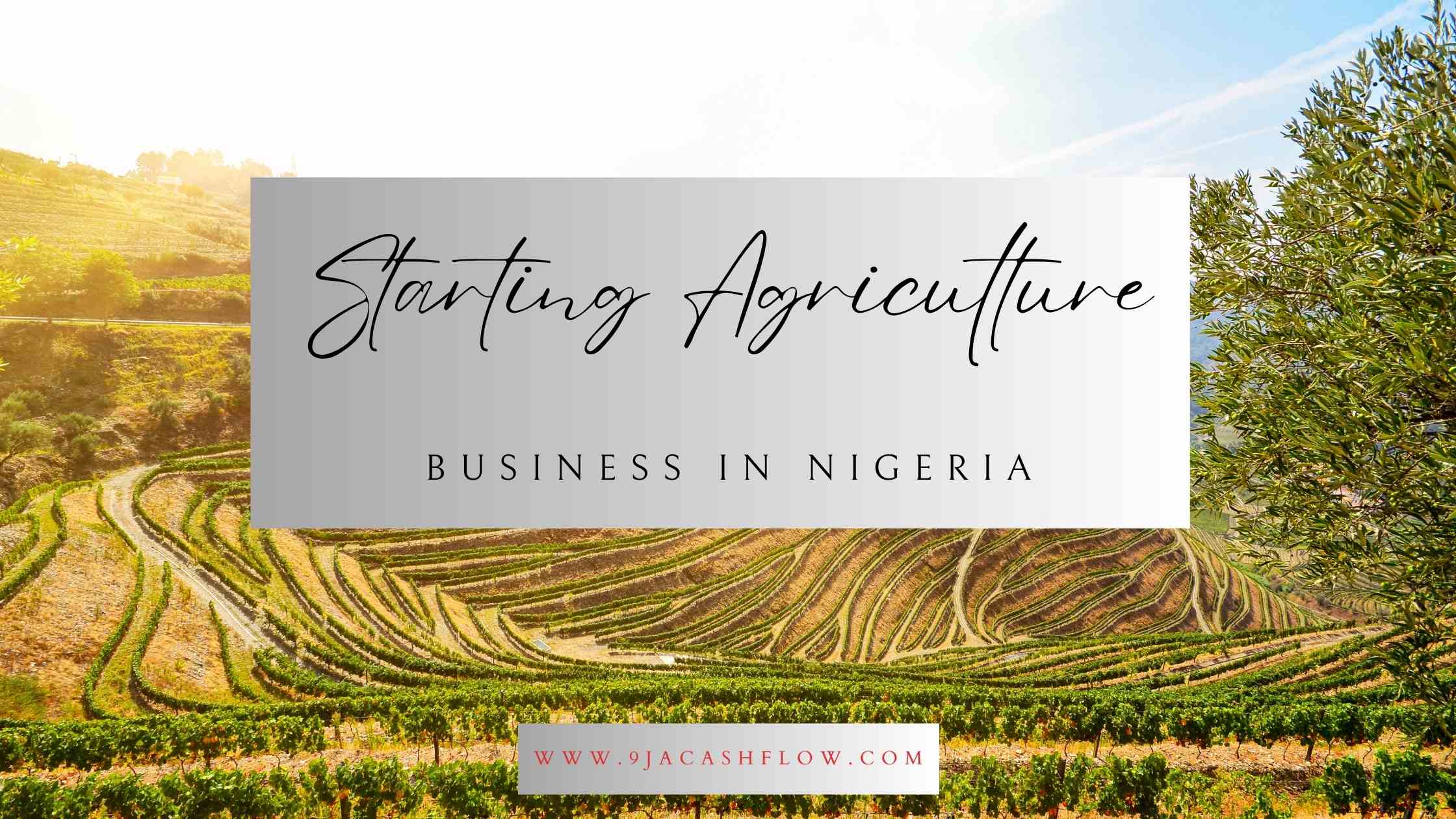

Good read.
Very insightful. Thanks for sharing.